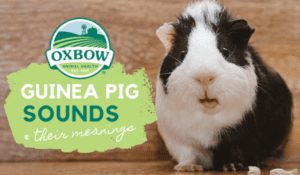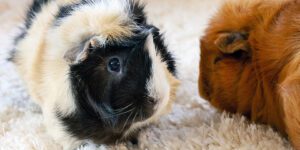Author: Kellie Hayden
Updated: January 18, 2024
Foot health is, frankly, not a topic at the forefront of every pet parent’s mind—and given everything else that pet parents must factor in when providing their pets with a happy and healthy life, it’s not shocking that foot issues may fly under the radar. This article covers two of the most common foot problems in guinea pigs, as well as methods of care and prevention.
Bumblefoot
What Is Bumblefoot in Guinea Pigs?
Bumblefoot (also called pododermatitis) is a common and highly preventable foot issue that veterinarians treat in guinea pigs. Bumblefoot is an infection of a guinea pig’s foot pad and is usually a result of inappropriate habitat conditions. Even mild cases of bumblefoot can be excruciatingly painful for pets—if you suspect your guinea pig is suffering from bumblefoot, seek the guidance of an exotics veterinarian right away.
While bumblefoot is a relatively common condition that veterinarians treat, it should not be considered normal or a “fact of life.” This is a preventable disease and can often be cured, but it can be fatal if not taken seriously.
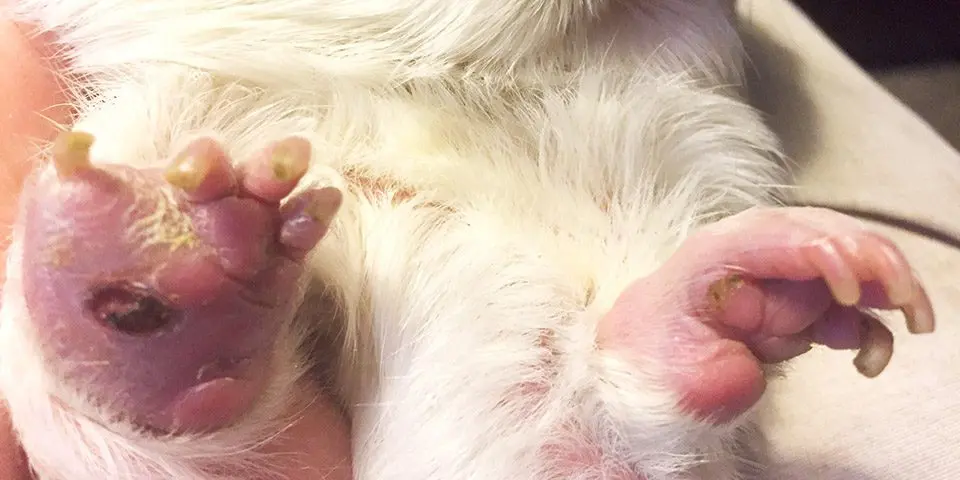
This is a severe and very painful case of bumblefoot in a guinea pig. The foot on the left is much more swollen compared to the foot on the right. Quality care and diligent treatment cured this case of bumblefoot! Photo provided by Asheville Guinea Pig Rescue.
Symptoms of Guinea Pig Bumblefoot
- Scrapes, scratches, or any kind of open wound on an animal’s foot pad
- Crusted over or opened scabs
- Limping, or decreased or limited mobility
- A reluctance to move around, run, or play
- Unexplained weight loss (due to pain and reluctance to get food)
- Symptoms of GI stasis – if your pet is exhibiting signs of GI stasis this is an emergency. Please seek veterinary care immediately.
- Unexplained weight gain (due to reluctance to exercise)
- Swollen, irritated foot pads—in the case of guinea pigs with pink foot pads, they will be red rather than a healthy pink
- Depressed mood or lower levels of activity and excitement
- In more severe cases, the entire foot or limb can appear swollen
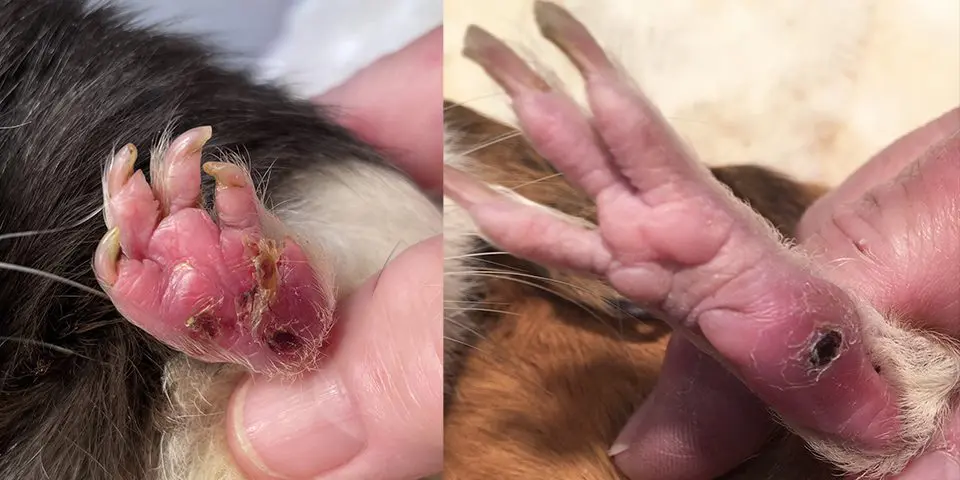
Notice how these two cases of bumblefoot have scabs and red, swollen foot pads. Photos provided by Metropolitan Guinea Pig Rescue.
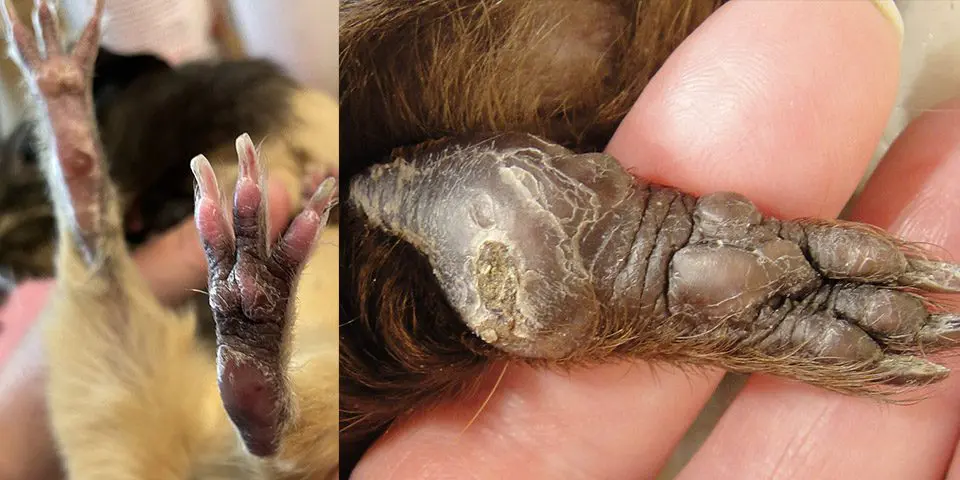
Some guinea pigs don’t have pink foot pads! In this case, it’s helpful to look for cuts or wounds, scabs, swelling, and dry, crusty foot pads, rather than redness. Photos provided by Metropolitan Guinea Pig Rescue.
Stages of Bumblefoot in Guinea Pigs
Early stage
In the early stages of bumblefoot, your pet’s feet may appear red or irritated. This can signal that something in their habitat is irritating their feet. While this is not quite an infection yet, pet parents should scrutinize their pet’s habitat for potential irritants and remove those irritants as soon as possible. If your pet does not live on a wire-bottom cage, irritants may be damp bedding or soiled hay.
Pet parents should also check that their pet’s toenails are not overgrown and causing pressure points on the feet. At this stage, make a point of cleaning your pet’s enclosure more than once a week to limit irritants and promote healing.
Mild
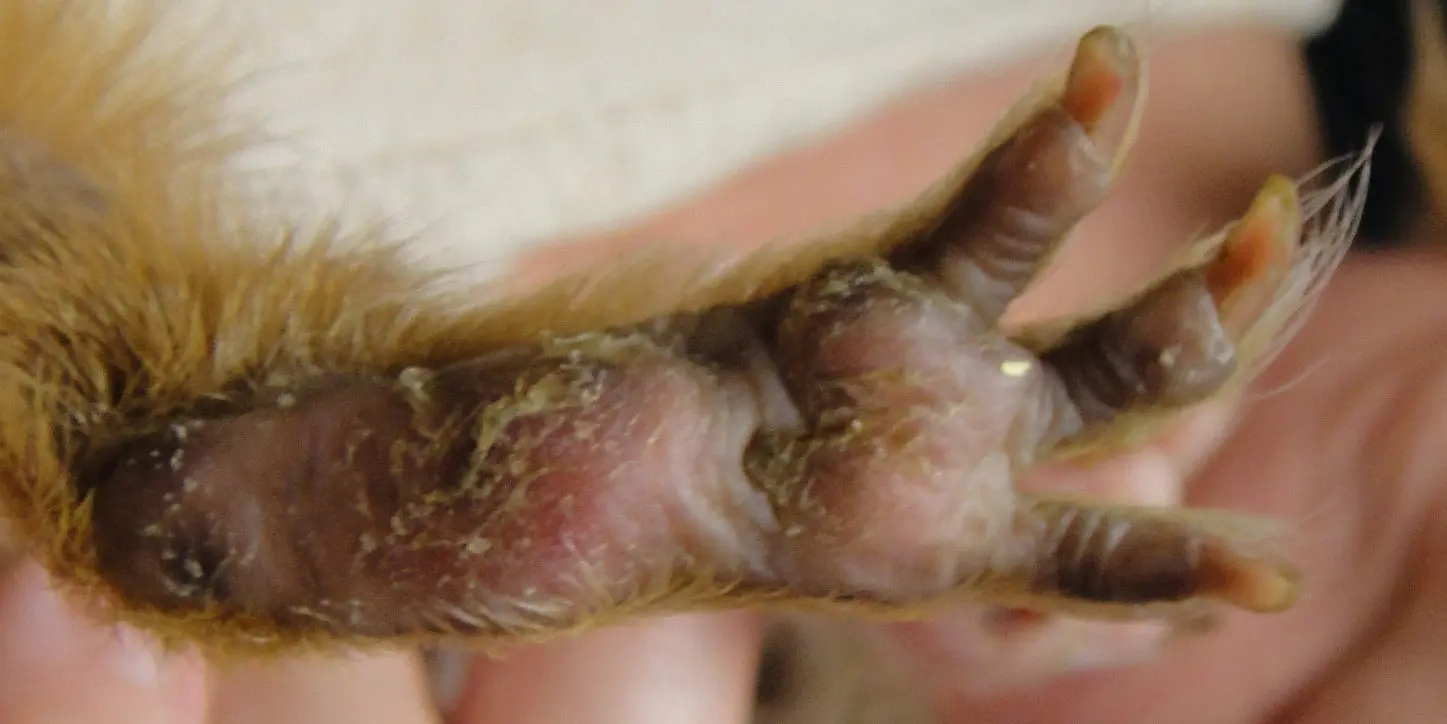
Photo provided by Metropolitan Guinea Pig Rescue.
In the mild stages of pododermatitis, your guinea pig’s foot pads may appear especially irritated, dry, and flaky, but the skin is not always broken, scabbed, or bleeding. If your piggie’s foot pads are normally pink, they may now be very red.
Habitat and nutritional improvements may turn a case like this around if improvements are promptly made. A check-up with your cavy-savvy veterinarian is still warranted to ensure there are no micro-abrasions on the sensitive foot pads that may let infection sneak in.
Moderate
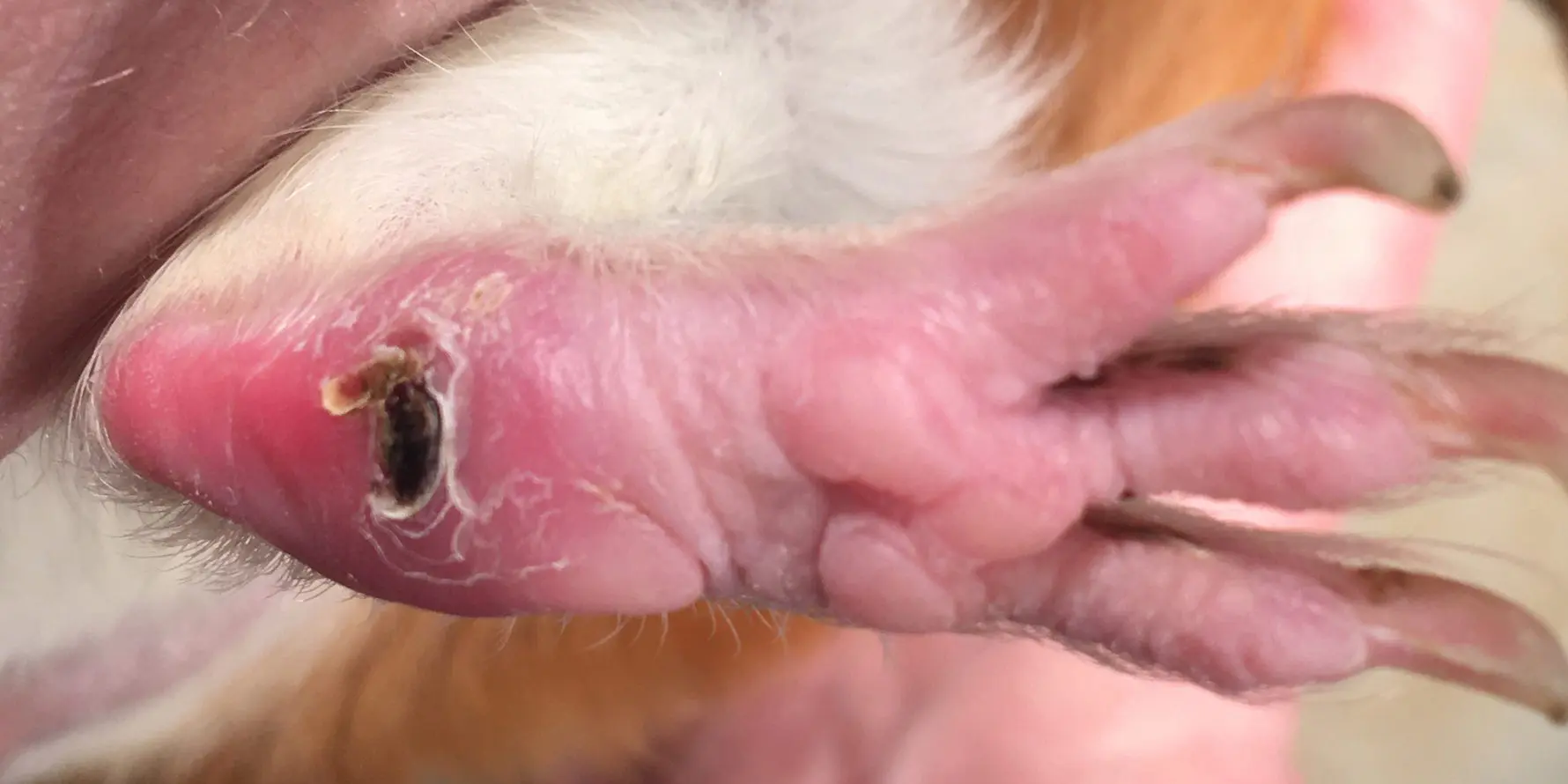
Photo provided by Metropolitan Guinea Pig Rescue.
In moderate cases of bumblefoot, the foot pad’s skin is broken. There is scabbing, bleeding, and inflammation. The guinea pig may favor their affected foot with a limp, exhibit lower activity levels, and experience weight changes. With proper veterinarian guidance, pain relief, antibiotics, and habitat improvements, cases like this can improve if professional help is sought quickly.
Severe
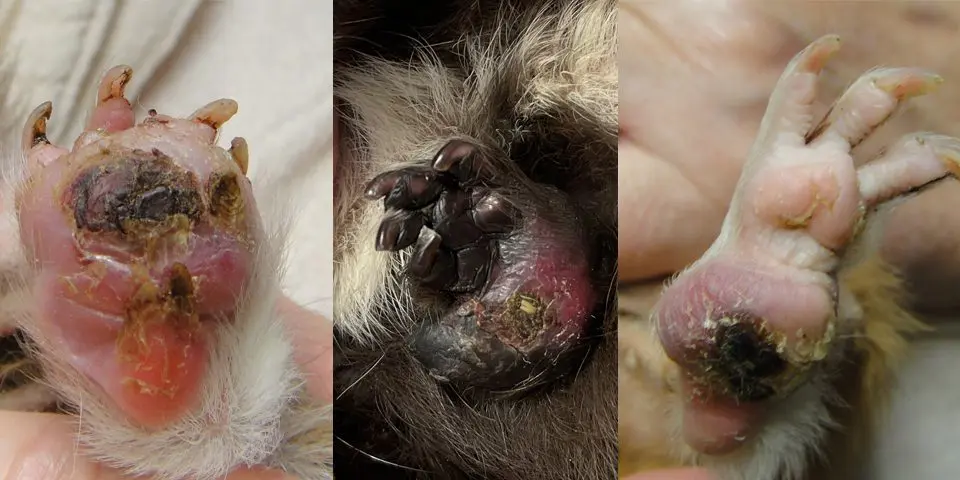
Photos provided by Metropolitan Guinea Pig Rescue.
In severe cases of bumblefoot, the foot pad skin is broken in one or more places. Scabbed or bleeding wounds are apparent. Swelling is significant, and debris may be present in the wounds. Your guinea pig, if they are walking at all, may have a significant limp, and likely will have experienced weight changes. While GI stasis is a serious concern no matter the severity of bumblefoot, it is especially a concern at this stage.
Infection in the affected foot is almost a certainty in severe cases and may have spread to the bone, which can be fatal. This is an emergency that requires immediate veterinarian care.
With diligent, aggressive treatment there may be improvements, but amputation cannot be ruled out if there is not rapid improvement. Keep in close contact with your veterinarian after initial assessment to describe improvements or declines in your pet’s appetite and mentation (“mentation” means your pet’s overall attitude; are they bright, happy, and alert? Or are they quiet, in a corner, and uninterested in their surroundings?).
Treatment
Bumblefoot must be treated with the advice of a cavy-savvy veterinary professional. Bumblefoot often requires antibiotics to target the bacteria causing the infection. Because pododermatitis is painful, guinea pigs also need pain management to keep them comfortable during the healing process.
After an assessment, your veterinarian may prescribe additional care that would benefit your pet’s particular case. This may involve medicated foot baths or wound wrapping. Your pet’s treatment plan should also include finding potential causes of bumblefoot and removing them from your pet’s living space.
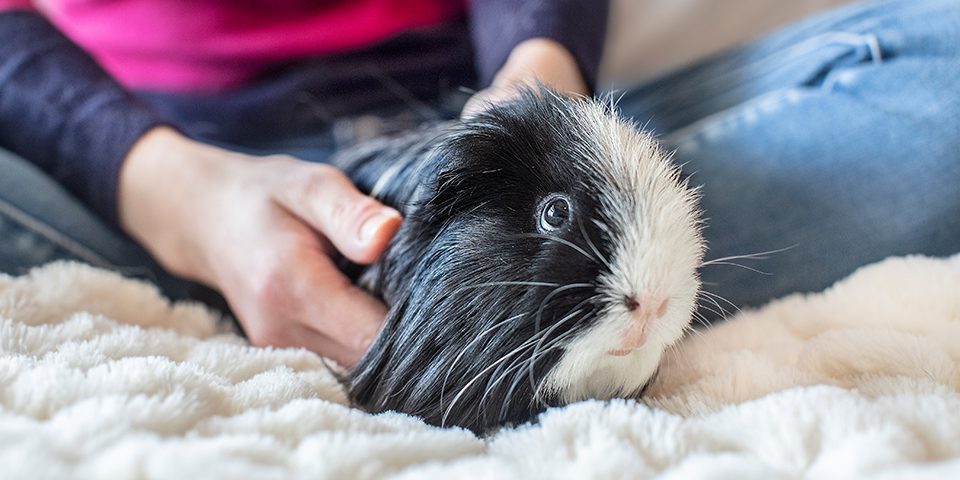
Causes and Prevention
Without addressing the underlying issues that cause bumblefoot, it’s possible for this condition to reoccur. If you can’t find the cause of your pet’s bumblefoot, speak with the cavy-savvy resources available to you, whether that’s your veterinarian, a local guinea pig rescue, or other pet parents for help. We also ask some questions below to help you begin the prevention process.
Is your pet’s enclosure free of a wire or grated bottom?
One of the most common causes of bumblefoot is the use of wire-bottom cages. While wire-bottom cages can make the cleaning process easier for pet parents, the grates irritate animals’ foot pads whenever they walk from one place to another in the enclosure. If a pet lives in a habitat with a wire or grated bottom, sores and open wounds can develop on their feet, leading to infection if untreated. Removing wire bottoms from enclosures, or replacing the enclosure altogether, is one of the most important steps you can take to prevent bumblefoot.
Are you changing your pet’s bedding enough?
A sanitary living space is also essential in bumblefoot prevention. Your guinea pig’s habitat should be cleaned at least once a week. The old bedding should be completely removed and discarded, the enclosure cleaned and dried, and fresh bedding added into the enclosure.
Damp or wet environments may play a role in the development of bumblefoot, and it is known that damp bedding can speed up infection if there are open wounds on a guinea pig’s foot. Check your pet’s habitat daily for excess moisture and replace wet bedding with dry bedding as necessary. If your pet’s habitat is overly wet from frequent urination, they may need to be seen by a veterinarian for urinary problems.
Is your pet getting the right nutrition and enough exercise?
Species-appropriate nutrition and plenty of exercise both increase your pet’s ability to fight off infection. Your pet also needs enough daily vitamins and minerals in the form of species-appropriate greens and a uniformly nutritious fortified food. Avoid fortified foods that contain dried fruits and seeds.
Guinea pigs in particular need vitamin C daily. While guinea pig food contains some vitamin C, offering a supplement is the best way to provide your pet with stabilized vitamin C.
Depending on your pet’s health status, additional vitamin supplementation may benefit them. Work with your guinea pig’s veterinarian to determine if a multi-vitamin is right for your little one.
Your pet should have regular access to space inside and outside of their habitat to run and play.
Are you trimming your pet’s toe nails regularly?
If your guinea pig’s toenails are too long, this can cause several issues for your pet. Long or curling toenails may cause unnatural pressure points on your pet’s foot pads, especially if the nails are growing into the foot. Long nails may cause your pet to walk with an unnatural gait, resulting in more unnatural pressure points. In addition, long nails can accumulate feces and bacteria, which can be both a skin irritant and a source of infection.
Just like people, guinea pigs need regular nails trims. If you need help with trimming your guinea pig’s nails, give your veterinarian a call. Many vet offices have LVT (Licensed Vet Technician) appointments available to help with difficult animal care tasks. We recommend nail trim appointments if your pet’s nails are particularly tricky to trim.
Accidental cuts to the foot pad during a trim can become a site of infection, so care should be taken during the trimming process. Always check your guinea pig’s foot pads after nail trims to check for cuts or nicks.
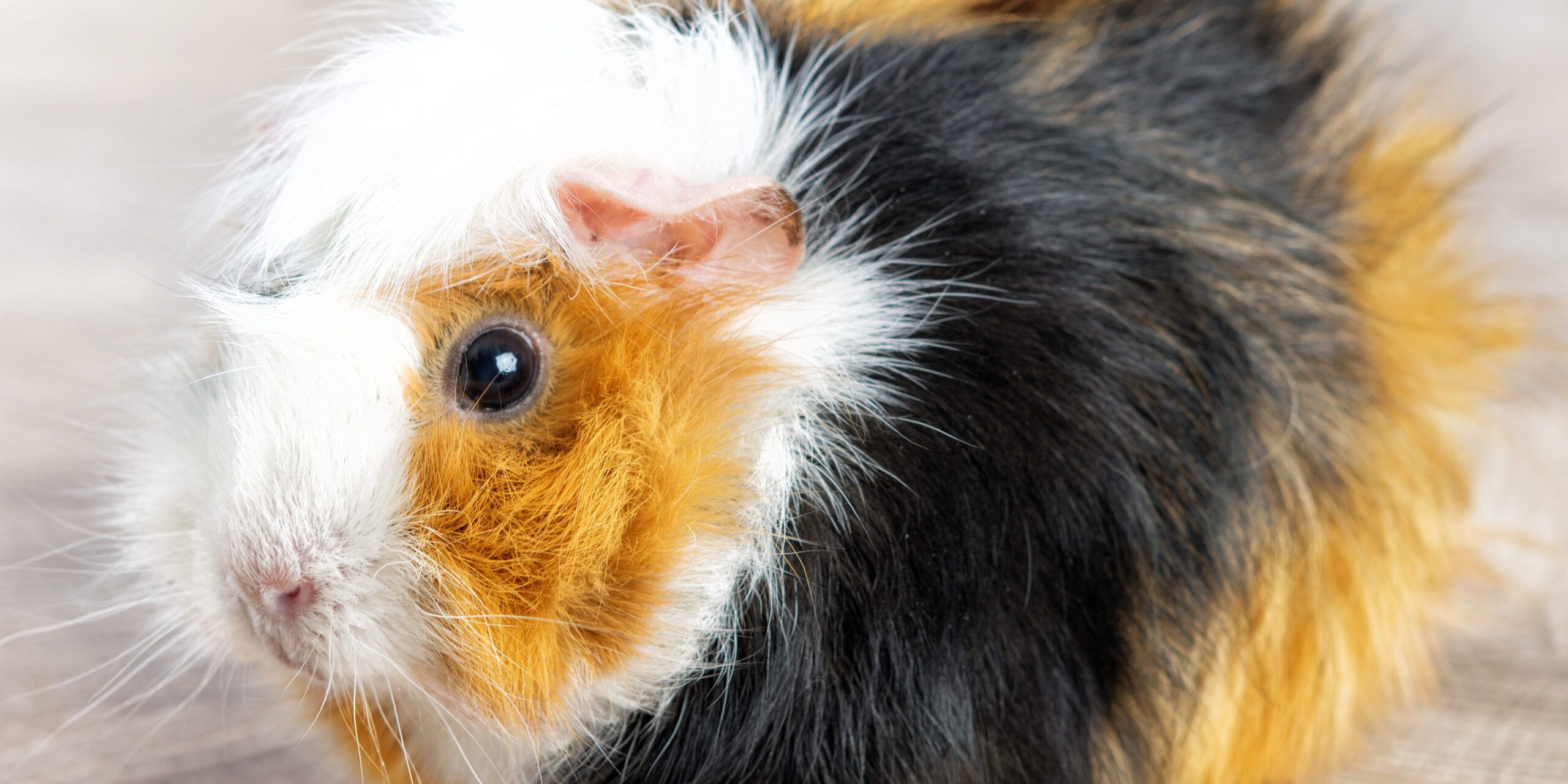
Conclusion
Bumblefoot takes time and effort to cure—there is no overnight fix. Your pet will need your dedicated care in order to recover.
As with other aspects of health, prevention is the best medicine! Many serious health issues can be prevented with proper care and maintenance, and bumblefoot is no different.
Foot Spurs & Corns
What Are Foot Spurs (Corns) in Guinea Pigs?
While this phenomenon doesn’t occur in all guinea pigs, your piggie may develop tough, crusty callouses on their feet. Some pet parents call them spurs, while others call them corns. This condition doesn’t necessarily pose a direct health threat to your pet, but it’s important to identify this condition. If left unmanaged, issues can arise from foot spurs that may pose a health risk later on, such a bumblefoot.
Depending on the location of foot spurs or corns on the foot pad, they can also cause pain or discomfort when your guinea pig walks, jumps, or plays. For this reason, spurs require a bit of additional care to limit the negative effects they can have on your guinea pig’s health.

“Spurs” or “corns” are found in different areas on the foot pad, and might vary in number from one individual to another. In all cases, however, pets with this condition need to receive proper husbandry to avoid complications like infection from tears in the skin. Photos provided by Asheville Guinea Pig Rescue.
Symptoms
Pet parents usually first notice spurs when they feel their pet’s paws in their hands. Smaller spurs can feel like a dry or rough protrusion from the foot pad; larger spurs can feel like a hardened flap of skin growing out of the pad.
If your pet has untrimmed spurs on their front feet, they may try to relieve discomfort by lifting their front feet into the air while their back feet stay firmly planted. This might be confused with (but is very different from) popcorning, where your guinea pig happily jumps and twists in the air. Use your pet’s behavior as a context clue to decipher the two behaviors from one another.
Causes and Prevention
The cause of spurs is relatively unknown, though genetics may play a role in their development. While there is no known way to prevent spurs, they can be managed similar to toenails to prevent more serious conditions from occurring.
Spurs may increase in number as your pet ages. Spurs can occur on all four feet, but pet parents may find that they’re more common on the front feet.
Treatment
Spurs may visually appear to be an issue of the outer layer of skin (the epidermis). In reality, they’re a condition that extends deeper into the dermis, which is the tissue underneath the epidermis. Similar to toenails, spurs can sometimes develop a blood flow. This means that you shouldn’t pull or scrape them off as a way to manage them.
Regularly trimming spurs can help ensure that blood flow does not extend far into this tough tissue. Trimming spurs can also go a long way in preventing tears and open cuts on the foot pad, thereby helping avoid infection.
Before trimming spurs yourself, we highly recommend taking your guinea pig to the vet for an LVT consultation. It’s very important to get a demonstration from an LVT on properly caring for this condition to avoid accidental cuts on your pet’s feet. Vet techs can show you what tools to use, tips and tricks for effective tool use, and safety precautions to take for your little one during the process. You may need regular vet tech assistance with spur trims depending on where they’re are located on your guinea pig’s feet.
Trimming foot spurs doesn’t need to be a monumental task, however. It can be done during your pet’s routine nail trim! Ideally, spurs should be trimmed back to about ¼ of an inch from the foot pad. Just remember to treat spurs like you would a toenail—do not trim them all the way to the pad or you might cut into the blood flow.
If your guinea pig has spurs, they might have scaly foot pads, especially in cold or dry weather. This can become uncomfortable and might reduce your pet’s activity levels. Rubbing a small amount of organic, cold-pressed coconut oil onto their footpad is a non-toxic option to help moisturize their foot pad’s skin and provide relief.
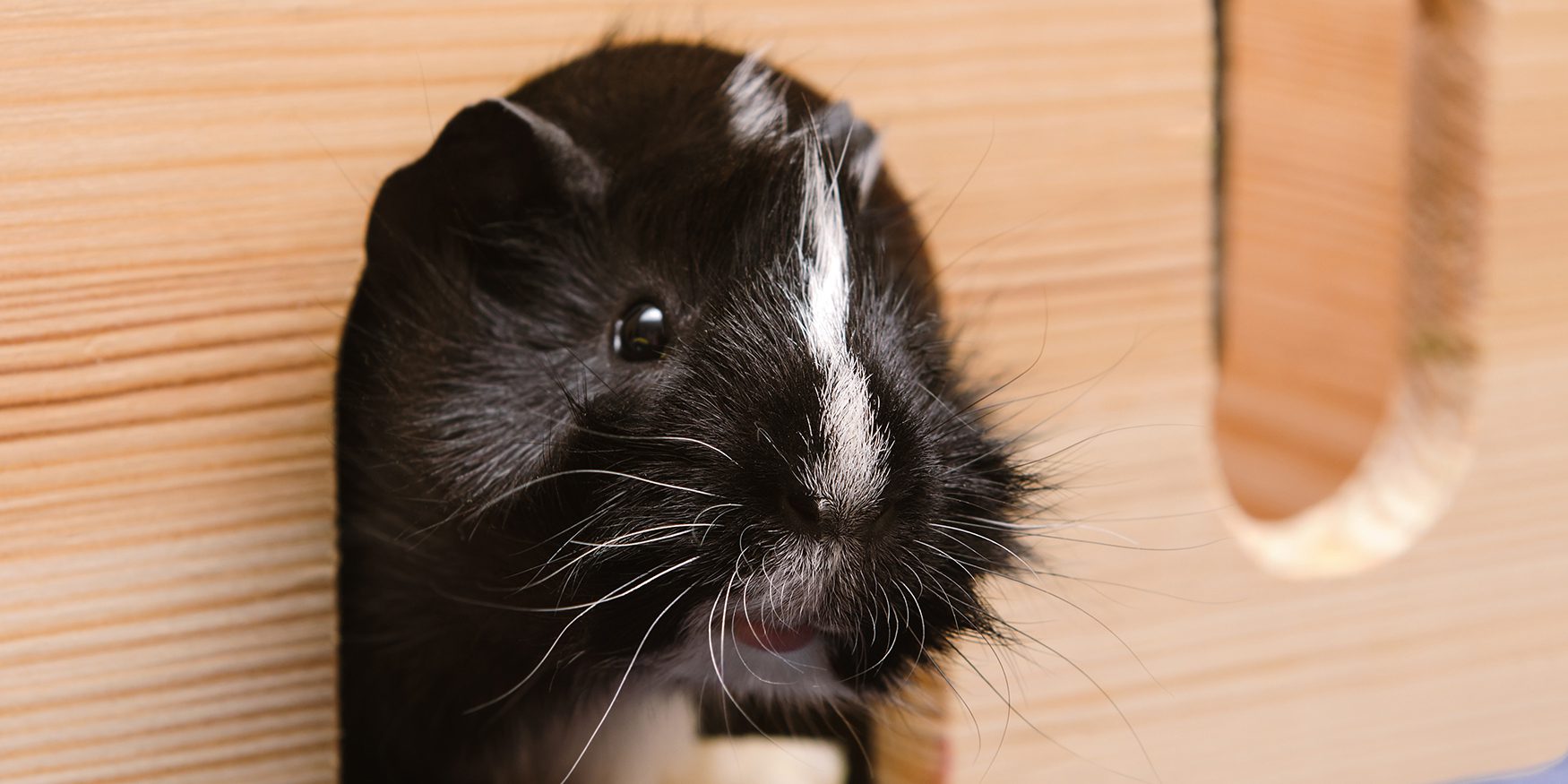
Common Causes of Guinea Pig Foot Problems
Guinea pig foot issues are not limited to just pododermatitis or spurs. We have answered additional questions below that pet parents may ask if they have arrived at this blog to understand foot health issues in their little one.
Why are my guinea pig’s feet red?
If your guinea pig’s normally pink foot pads are red, that is generally a sign that something in their living space is causing irritation, inflammation, or unequal pressure on their foot pads. Assess your pet’s habitat to find and remove potential irritants.
Why are my guinea pig’s feet swollen?
While there can be many reasons, swollen feet in guinea pigs can be a sign that their feet are injured. The reason for this swollen appearance requires a deeper look at other symptoms they present with, in addition to a close look at their habitat and living conditions.
Why are my guinea pig’s feet bleeding, scabbed, or wounded?
If your guinea pig’s feet are bleeding or scabbed, they need to be promptly seen by a veterinarian for species-safe pain relief and antibiotics. When your guinea pig’s foot pad skin is broken or scabby, their habitat may be part of the problem, whether that’s a wire bottom cage or inadequate bedding.
Why are my guinea pig’s feet dry, cracked, or callused?
Dry, cracked, or callused feet can be a sign of irritated foot pads in guinea pigs. While not always the case, it can be a result of poor animal husbandry, such as soiled bedding that is not changed enough.
Feet in this condition can advance into bumblefoot if action is not taken to remove irritants in the habitat. If improvements are made but there is no change or your guinea pig’s condition worsens, make an appointment with a cavy-savvy veterinarian to professionally assess the issue.
Why is my guinea pig limping?
If your guinea pig is limping, they need to promptly be seen by a veterinarian. Limping is not normal, and while limping could be sign of bumblefoot or foot spurs, it could also be a sign of serious injury or a severe nutritional deficiency.
We’d like to thank Asheville Guinea Pig Rescue and Metropolitan Guinea Pig Rescue for providing photos of spurs and bumblefoot. Both rescues have many guinea pigs looking for forever homes—and both rescues are a wealth of knowledge for potential fosters and adopters! We’d like to encourage those who found this article informative to show your support for these two amazing organizations.
Learn more about how to keep your cavy happy and healthy with Oxbow’s beginner’s guide to guinea pig care!

